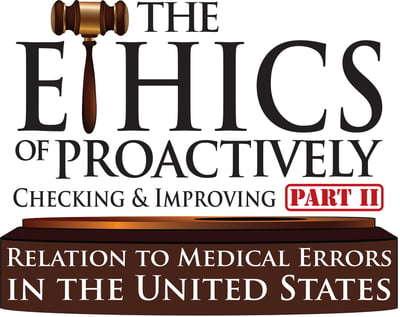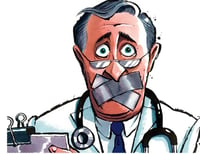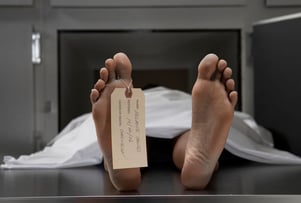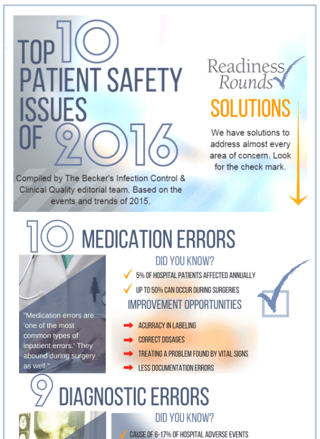
Recently, we published Ethics of Proactively Checking & Improving, Part 1 in this series.
At that time, I had no intention whatsoever to expand the topic into a series. I changed my mind just a few days ago. I admit, at the time of this writing, I’m a bit frustrated. Be forewarned! Some of this may come off as a rant and full of my personal opinions, but rest assured, I will at least offer some possible solutions to some of what I’m “ranting” about. Please read on. 
A new BMJ report came out stating that medical errors are currently the 3rd leading cause of death in the U.S.
In healthcare, we all know this already; and in Part 1 of this series, I cited a study (see the synopsis in HeathIT News here) from several years ago that puts the number at 400,000 dying each year from medical errors in the U.S.
So, although it’s full of old information the industry is well aware of (I’m sure your hospital doesn’t have any issues though, right?) , it seems to point at the fact that we have not seen improvement, except maybe somewhat in HAIs (healthcare-associated infections).
, it seems to point at the fact that we have not seen improvement, except maybe somewhat in HAIs (healthcare-associated infections).
Horrible news for quality of care and patient safety in the U.S.
Aren’t healthcare organizations working toward High Reliability? Or is that still just talk?
Two parts that stuck out to me in this Huffington Post article on the BMJ findings:
“In healthcare, the same mistakes happen again and again, and many of them are never investigated.”
My take:
While this is surely complicated, maybe even nebulous in scope, and although I may be taking a simplistic view on this, there are plenty of tools that healthcare organizations can acquire to change this.
These tools allow the organizations to quickly trend, diagnose and improve performance in areas where there have been lapses in procedures or errors observed (CAUTI, CLABSI, patient falls, pressure ulcers, HL disinfection, hand hygiene etc. etc.). 
But that would require healthcare organizations to actively move toward High Reliability, and that takes resources and a significant culture shift. Which moves me to another quote below that proves bothersome when you consider how many people are being harmed and some dying (just several hundred thousand a year – felt like I should throw that in there again) from preventable medical errors.
And the second thing that stood out to me from this article:
“Each year, the U.S. Agency for Healthcare Research and Quality receives thousands of project proposals aimed at reducing preventable harm, but very few ever get funded because funding work on the delivery of care has historically taken a back seat to funding new treatments.”
My take:
Now while this is referring to a government organization rather than an individual hospital or healthcare system, which is what I traditionally work with, it still makes a valuable comparison.
I find it almost comical when I encounter healthcare organizations that market their cutting-edge technology for some new form of treatment for heart disease or cancer.
But all of the proactive checking through hospital rounding/checklists/tracers – whether it be environment of care, infection control, pharmacy, leadership or whatever – whomever is doing the rounding, is doing it on a piece of paper to be put onto a clunky spreadsheet (often times nothing is done with it) so some committee can talk about how they keep finding the same issues time after time and they don’t know what to make of the “data.”
Issues routinely fall through the cracks until the hospital is in their “survey window.”
Although many hospitals have moved to using technology and shifting to a High Reliability mindset to improve this in some areas, we have a longggggg way to go as an industry – obviously with the current statistics.
Essentially, the takeaway here is the number 1 and 2 killers in the U.S., Heart Disease and Cancer, are worth addressing by healthcare organizations with significant investment and resource allocation.
But apparently, lowly 3rd place Medical Errors is not worth the same time or investment by the very same organizations causing the issues.

So what is the solution? I would argue that a real industry-wide push to High Reliability needs to occur in healthcare.
So far, except for a few rare instances, many hospitals are just dipping their toes in the High Reliability pool, not really wanting to invest in the resources, culture shift and manpower required for the full jump.
Please visit the following articles for more insight on High Reliability in healthcare:
One piece of the solution is where my organization, Readiness Rounds, comes into play.
This piece is performance improvement, which is critical on the path to High Reliability and harming fewer patients.
Traditionally, hospitals will throw some budget at us to help make sure they pass their TJC survey. And that’s great!
But the issue is that proactively checking processes, protocol and staff knowledge, then ultimately improving performance on them, as something only to be done during your survey window is a slap in the face of patient safety.
And that’s the way hospitals have been doing this for a long time. This accreditation and compliance-only mindset in conjunction with archaic, inadequate and infrequent checking reliability of processes and protocol is one of the big factors that allows issues to fall out of the loop and for patients to be harmed.
What are your thoughts on this? Feel free to comment below.
For more insight on how Readiness Rounds can help your organization reduce medical errors, contact us here.
